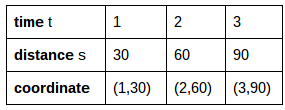Lines in Everyday life
A CAR JOURNEY
Linear relationships can describe many everyday situations such as a car journey. A car travelling at say 30 km per hour will travel a total distance of 30km in one hour, 60km in the two hours, and 90km in three hours, etc. We can write a mathematical relationship between the distance travelled s, the velocity v, and the time t (in hours):
we can pick values for the time t and calculate the distance s travelled as shown in the table:

and then plot the time-distance coordinates. A straight line is the drawn through these points as shown below:
The time-distance line becomes steeper as you increase the velocity of the car:
Finding the Velocity From a time-distance graph
The velocity can be determined by inspecting a time-distance Graph. The distance travelled s is:
this means we need to find one point on the line and then divide the distance travelled by the time to calculate the velocity. We can't however use the coordinate (0,0) even though its on the graph, since 0/0 is not a quantity that can be determined so we say that 0/0 has an indeterminant form.
Exercise: Determine velocity from the graph
Have a calculator ready. Move the point on the line using the slider to find a coordinate, then calculate and enter the velocity. Repeat the exercise a few times to consolidate your knowledge.
Summary
(i) The time-distance graph for constant velocity can be drawn by plotting two coordinates and then drawing a line through these points. (ii) Given a time-distance graph the velocity can be found by inspecting the graph. All of this may seem easy (and it is) and we shall revist these ideas in later posts: where the algebra will be more complicated making it possible to overlook simple visual concepts which are still valid.